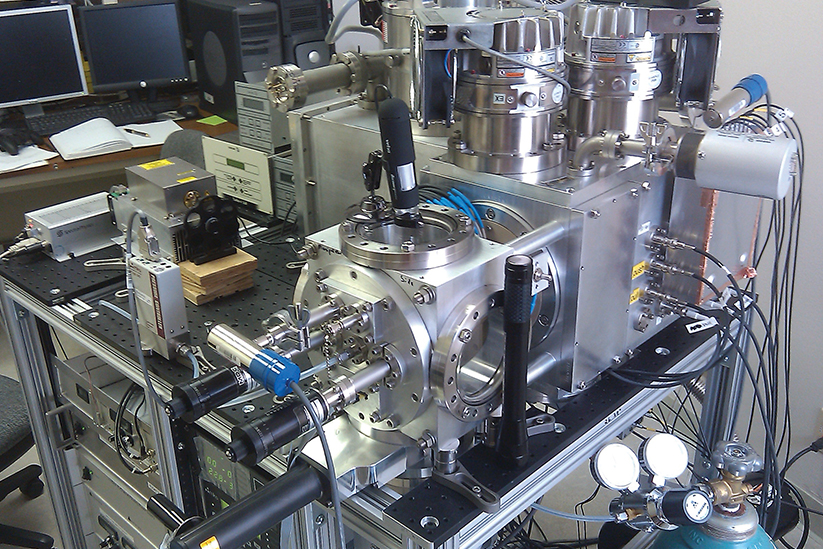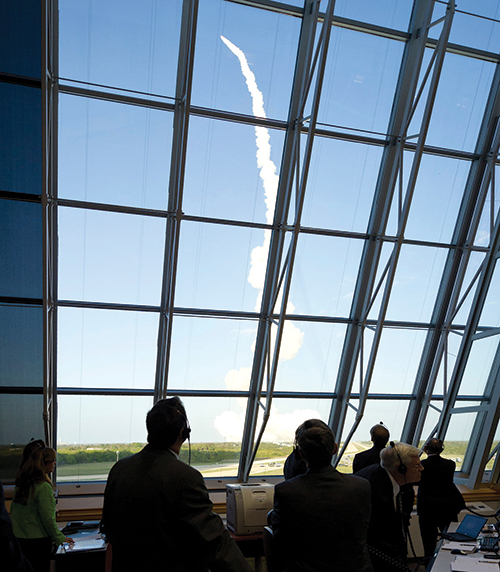
Mass Analyzers Facilitate Research on Addiction
NASA Technology
The famous “go/no go” command for space shuttle launches comes from a place called the Firing Room. Located at Kennedy Space Center in the Launch Control Center (LCC), there are actually four Firing Rooms that take up most of the third floor of the LCC. These rooms comprise the nerve center for space shuttle launch and processing.
Test engineers in the Firing Rooms operate the Launch Processing System (LPS), which is a highly automated, computer-controlled system for assembly, checkout, and launch of the space shuttle. LPS monitors thousands of measurements on the space shuttle and its ground support equipment, compares them to predefined tolerance levels, and then displays values that are out of tolerance. Firing Room operators view the data and send commands about everything from propellant levels inside the external tank to temperatures inside the crew compartment. In many cases, LPS will automatically react to abnormal conditions and perform related functions without test engineer intervention; however, firing room engineers continue to look at each and every happening to ensure a safe launch.
Some of the systems monitored during launch operations include electrical, cooling, communications, and computers. One of the thousands of measurements derived from these systems is the amount of hydrogen and oxygen inside the shuttle during launch.
Partnership
In 1999, to enhance the technology that continuously monitored these gas levels inside the orbiter while on the launch pad, Kennedy awarded a Small Business Innovation Research (SBIR) contract to Houston-based Ionwerks Inc. to fabricate a small, fast, time-of-flight mass spectrometer (TOFMS).
A TOFMS is one of many different types of mass spectrometers for measuring the exact weight of molecular ions (created by electron impact ionization of molecules). These molecular ions can be present in parts per million (ppm) levels in solids, liquids, gasses, and plasma. For leak detection of hydrogen and oxygen within the orbiter at Kennedy, ions were created from atmospheric gas samples. The TOF analytical technique separated the different ionized molecules according to their weight by measuring the time it takes for them to travel across a fixed distance.
Ionwerks’ previous collaborations with organizations such as Argonne National Laboratory, the National Institutes of Health (NIH), Texas A&M University, Rice University, and several companies helped Ionwerks evolve dual-use electronics in TOF mass spectrometry, based on timing chips originally developed for high energy physics. Since Ionwerks had already commercialized the crucial components, an advanced compact TOF instrument was rapidly prototyped through the SBIR partnership to provide a rugged, low-power option for quick remote monitoring of the gas composition inside the space shuttle.
According to Al Schultz, the founder of Ionwerks, “The application at Kennedy was unique, and we demonstrated that the instrument could be fast and accurate for determining parts-per-million changes in hydrogen and oxygen on top of large signals already present in the orbiter atmosphere. After the SBIR, we used the experience and the electronics as a springboard to do other work, especially in the area of detecting large molecules on surfaces—especially bio-surfaces.”
Benefits
Over the last decade, as a result of its SBIR work with NASA and NIH, Ionwerks’ technology has taken two commercial paths: one in Europe and one in the United States.
Two researchers who were employed at Ionwerks during the NASA SBIR, Katrin Fuhrer and Marc Gonin, adapted the approach to improve a commercial gas analyzer for environmental monitoring of airborne contaminants. “By replacing a quadrupole mass spectrometer with the TOF, all masses are measured at once,” says Schultz. “More sensitivity is achieved, even at a specific mass, than with the quadrupole.” The technique quickly and precisely determines the composition of a sample. To provide the NASA-inspired technology for industrial, government, and academic research labs, Fuhrer and Gonin founded a company in Thun, Switzerland, called Tofwerk.
Back in the United States, Ionwerks incorporated many of the innovations developed during the SBIR with Kennedy into its commercial laser imaging spectrometer for surface analysis. Today, Ionwerks sells the complete spectrometer to industrial, government, and academic laboratories for biological mass spectrometry and basic biological research. One of the instrument’s unique features is its precision, which allows users to see subtle differences in the masses and shapes of compounds desorbed (released) from a surface.
For one application, Ionwerks’ spectrometer has been incorporated into ongoing contractual and SBIR work with the NIH’s National Institute on Drug Abuse (NIDA). “Most of the hardware and electronics we developed for NASA found dual use in work with NIDA,” says Schultz. “After engineering the technology with NASA, it was easier to evolve a unique instrument for the NIDA applications.”
Research led by Amina Woods at NIDA’s Intramural Research program is aimed at imaging biological tissues to search for biomarker molecules as indicators of addiction or brain injury. Ionwerks’ molecular imager combines mass spectrometry with an ionization method called matrix assisted laser desorption ionization (MALDI) and a gas phase separations technique called ion mobility spectrometry to locate and identify large biomolecules on the surface of biological samples.
“If you move the laser focus from one spot to the next spot and measure the number and type of ions originating from each spot, you can create an image—a molecular map—of what molecules are where on the surface of the tissue. If researchers can find biomarkers that are collocated with diseased areas, then perhaps it will be possible to chemically mitigate neurological disease or injuries,” says Schultz. Ultimately, NIDA is attempting to correlate the presence of certain molecules with cases of addiction. Schultz notes, “If the tool can be used for one set of neurological problems, it can be used for others.”
In 2006, the company was recognized for its work with NIDA with the prestigious “Tibbetts Award” for small businesses and SBIR support organizations exemplifying the types of business, economic, and technical development goals of the SBIR program.
Without the SBIRs and use of retained earnings from Ionwerks’ commercial sales, Schultz says the work to create the product would not have been possible. But aside from the success of the instrument, Schultz hopes for the success of something even bigger. “Our company hopes to help the research community, all the people doing molecular imaging, to develop technologies that will use ever-improving instrumentation to achieve more specific molecular information, even within single cells,” he says. “Everyone in this field shares the dream that molecular imaging technology will ultimately be used clinically for early onset detection of diseases in time to do something about them.

Inside the firing room at Kennedy Space Center, members of the NASA management team watch the final launch of Space Shuttle Discovery on February 24, 2011.

After working with NASA, Ionwerks Inc. used its experience and electronics to develop this system for imaging biological tissues at the National Institutes of Health’s National Institute on Drug Abuse.













